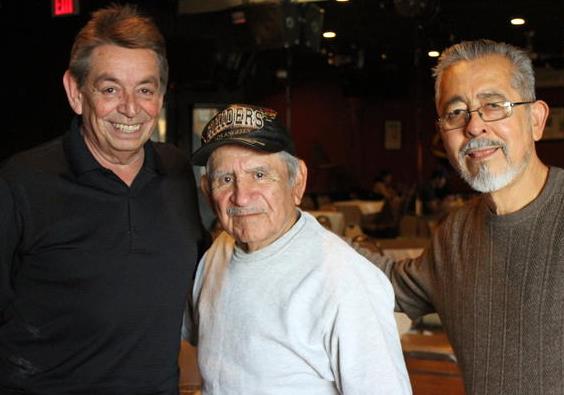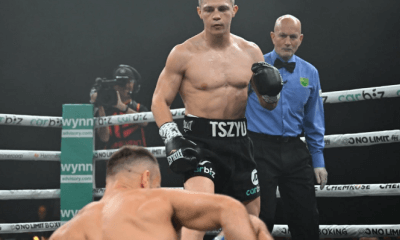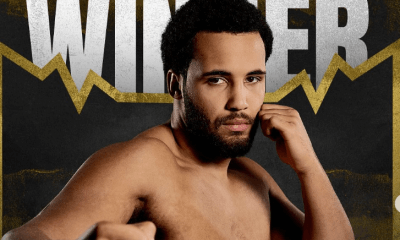Featured Articles
L.A. Sports World Loses “Chiquilin,” Photographer Extraordinaire

One of the icons of Los Angeles sports journalism, Jose “Chiquilin” Garcia Martinez, passed away last week. Though not very tall in physical height, he wielded a powerful influence on those who knew him.
“Chiquis,” as some called him, always wore a baseball hat adorned with medals and trinkets. And he almost always placed it backwards on his head, the better to take fast action shots of boxers, baseball players and other sports figures.
For one half century Chiquilin crossed paths with sports figures like Ruben Olivares, Fernando Valenzuela, Hugo Sanchez, David Beckham, Kirk Gibson, Magic Johnson, Oscar De La Hoya and Kobe Bryant.
Or maybe they crossed paths with Chiquilin?
No other sports journalist, especially a sports photographer, ever wielded as much influence as Chiquilin who could convince a much revered sports athlete to come out of hiding or an entire team to give a gathering of reporters a few minutes of time. He always seemed to be everywhere for every event.
Ironically, he never drove or owned a car in Los Angeles.
Always dressed in humble attire Chiquilin was an integral part in building the Spanish newspaper La Opinion into a force in Southern California. It was one of the leading Spanish language newspapers in the entire U.S. for a number of decades.
Fernando Paramo, the former sports editor for La Opinion, said when he became sports editor in the early 1980s he joined forces with Chiquilin to scour the sports world for their readers. Los Angeles was the center of sports as the Olympics arrived, Dodgers fought for pennants, Lakers won titles and the soccer world began arriving along with large influxes of Latinos from other countries.
“We were there when Julio Cesar Chavez won a record 100 wins, when he beat Meldrick Taylor and when he lost to Frankie Randall. We were there when jockey Laffit Pincay got seven wins and when Kirk Gibson hit the home run in the World Series. Any of the large events Chiquilin was there taking photos that we sent all over,” said Paramo. “We were like the Associated Press.”
When Fernando Valenzuela became an instant phenomenon in 1981 as a young teen-age pitcher for the Dodgers, one of the first to greet the Mexican southpaw was Chiquilin.
“He took Fernando Valenzuela around the area to help find him a house when he first arrived,” said Paramo. “Valenzuela was very shy.”
Bill Caplan, a sports publicist for many decades, said for as long as he can remember Chiquilin was a revered and beloved photographer who hardly ever spoke English but could communicate almost magically.
“We had our own kind of language. I don’t know how to explain. I don’t speak much Spanish and he didn’t speak much English but we always understood each other,” said Caplan laughing at the memory of their conversations.
Caplan said it was Chiquilin that helped introduce Dodger great Valenzuela to the late great newspaper columnist Allan Malamud who would go on to introduce the Mexican star to the English-speaking world.
Over the years Caplan saw the influence and recognition that the hustling Chiquilin had with major sports stars and his knowledge of the sports world.
“Once I was hired to do publicity for Julio Cesar Chavez in Arizona during his comeback and I asked Chiquilin if anybody would come to the fight,” said Caplan. “He told me it was going to sell out. It did. There were not even seats for the press, the promoter had sold them.”
“Hijo”
Chiquilin’s influence crossed borders as well.
Ricardo Jimenez, a former reporter for La Opinion and now a publicist, said when working with Chiquilin it was like an adventure. And, that the sports photographer seemingly knew everyone.
“Once we had to cover an event in Mexico City and we were on deadline and I asked him how we were going to send it? Don’t worry hijo,” said Jimenez. Hijo means son in Spanish. “He always called everyone hijo.”
Jimenez said that night in Mexico City, Chiquilin walked with him out of the stadium and crossed a few streets and took him to a dark building and then into offices where people greeted Chiquilin by name and allowed them to send the stories and photos to Los Angeles.
“He knew everybody,” said Jimenez. “And everybody knew him.”
Jimenez also said he had a strong sense of duty as a journalist.
“Chiquilin would always say we have to cover all the major sports,” said Jimenez, who was an intern at the Los Angeles-based newspaper when he first met Chiquilin. “When we began covering the Lakers they used to put us in the rafters and he would be shooting from way up there at the Forum. Pretty soon they (Lakers organization) knew we were serious about coverage and we were sitting down below. Chiquilin would leave early and take the bus to the office to process the photos. He never drove. He knew all the bus routes.”
Nobody hustled like Chiquilin.
ChiquiTron
He was a one-man army if necessary. Sports was in his blood and he did whatever it took to move the needle forward. One way he covered his own costs was obtaining tickets from athletes and selling them for money and favors.
“He sold so many tickets to people we used to call him ChiquiTron,” joked Paramo in reference to Ticketron.
Eventually an undercover officer caught Chiquilin selling tickets for an event and he was forced to go to court in front of a judge, explained Paramo.
“Once at a big fight an undercover cop got him for selling four ringside tickets. He goes to court and was asked by the judge: how do you plead? Chiquis said: ‘no contest with an explanation. I’m a photographer, I send pictures to Mexico. People over there asked me to get them some tickets for the fight. So I bought them. But they couldn’t make the fight. I make $4.50 an hour and the tickets cost so much, that’s almost half of my week’s salary and so that is the reason I have to sell them.
Judge says ok. We’ll wave off any fine. Can I see you in the chambers? So Chiquilin goes and meets the judge who asks him for tickets to a big game, so he sold them to the judge. That’s the kind of guy Chiquilin was.”
Paramo said that super stars like Muhammad Ali and power executives like Peter O’Malley would accommodate Chiquilin. Even in the cutthroat world of boxing he was known and trusted.
“When Tommy Hearns fought Pipino Cuevas they left the purse money with Chiquilin. That’s how much trust they had in him,” said Paramo adding that he put the cash in his photography bag.
Joel De La Hoya, the older brother of Oscar De La Hoya remembers meeting Chiquilin during the return from the 1992 Barcelona Olympics.
“I remember him asking for a team uniform when we were in Big Bear for one of our first training camps at our compound,” said De La Hoya. “I gladly obliged. Every camp there after I would hook him up with DLH apparel. He was very grateful and we were as well for those famous Chiquilin shots. He always got the shot.”
The Master
During these last few years Chiquilin’s health deteriorated and he was unable to scramble for photos on the boxing apron or chase the action photo of a lifetime.
“Once after an important soccer game someone asked him did you catch the ball going through the net?” said Paramo. “No, he answered, but not even the goalie did. That was Chiquilin.”
Caplan said a few years back he renewed his vows with his wife and asked Chiquilin to be the photographer and he obliged. After hours of taking photos of the family event which included boxing great George Foreman as a guest, he met with the photographer to pay him.
“Chiquilin wouldn’t take any money, no matter what,” said Caplan. “He was such a great guy. If I talk anymore I’m going to cry.”
Speaking for myself, I met Chiquilin around 1993. He was always very giving of his time and through the years he would greet me as a kind of fellow hustler, someone who like himself, tried to cover everything. We crossed paths so many times I couldn’t possibly put a number on it.
One time, about 20 years ago, I was involved in a heated discussion with a person who had several accomplices at a boxing event. Words were exchanged and other reporters could see it was a dangerous situation about to explode. I expected the worst but I wasn’t going to retreat and they weren’t going to retreat. More challenges were made and I countered those challenges and was willing to accept whatever came regardless if it was me against six. Suddenly, I hear a voice next to me and it’s Chiquilin asking me “hijo, you need help?”
I never forgot that. Of all the people there who knew me and could see trouble about to erupt, only Chiquilin stepped up to assist me if necessary. The smallest guy was willing to go up against these massive guys. That’s the kind of man he was.
I will never forget Chiquilin as I’m sure many others will never forget the massive heart of this great human being and a grand master to us all. It’s the end of an era and he will be greatly missed by those who knew him.
Chiquilin was the father of two daughters and lived with his wife in Huntington Park.
Memorial Services information
The memorial services take place on Saturday March 2, at Guerra Cunningham Bagues 6351 Seville Ave. Huntington Park, Calif. 90255. The viewing begins at 11 a.m. Rosary takes place from noon to 1 p.m. Viewing ends at 3 p.m. For more information call (323) 582-6197.
Photo: “Chiquilin” is flanked by La Opinion colleagues Fernando Paramo (l) and Rigo Cervantes
Check out more boxing news on video at The Boxing Channel
To comment on this story in The Fight Forum CLICK HERE
-

 Featured Articles4 weeks ago
Featured Articles4 weeks agoThe Hauser Report: Zayas-Garcia, Pacquiao, Usyk, and the NYSAC
-

 Featured Articles3 weeks ago
Featured Articles3 weeks agoOscar Duarte and Regis Prograis Prevail on an Action-Packed Fight Card in Chicago
-

 Featured Articles2 weeks ago
Featured Articles2 weeks agoThe Hauser Report: Cinematic and Literary Notes
-

 Book Review2 weeks ago
Book Review2 weeks agoMark Kriegel’s New Book About Mike Tyson is a Must-Read
-

 Featured Articles4 weeks ago
Featured Articles4 weeks agoRemembering Dwight Muhammad Qawi (1953-2025) and his Triumphant Return to Prison
-

 Featured Articles7 days ago
Featured Articles7 days agoMoses Itauma Continues his Rapid Rise; Steamrolls Dillian Whyte in Riyadh
-

 Featured Articles3 weeks ago
Featured Articles3 weeks agoRahaman Ali (1943-2025)
-

 Featured Articles3 weeks ago
Featured Articles3 weeks agoTop Rank Boxing is in Limbo, but that Hasn’t Benched Robert Garcia’s Up-and-Comers



















